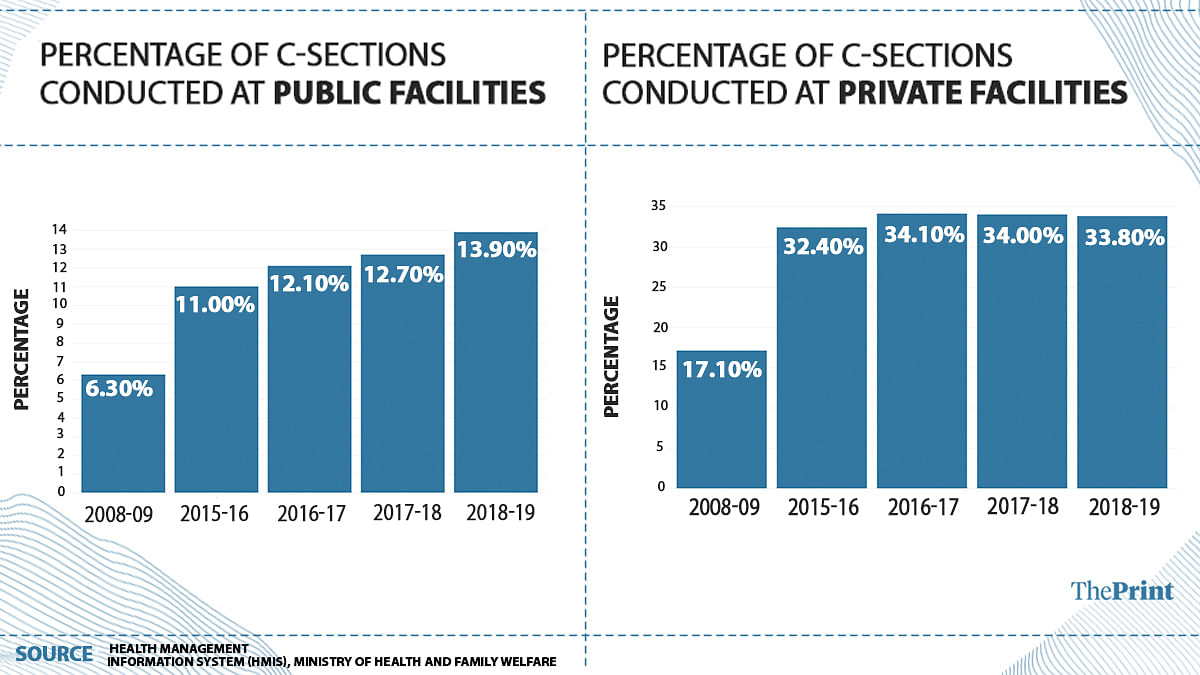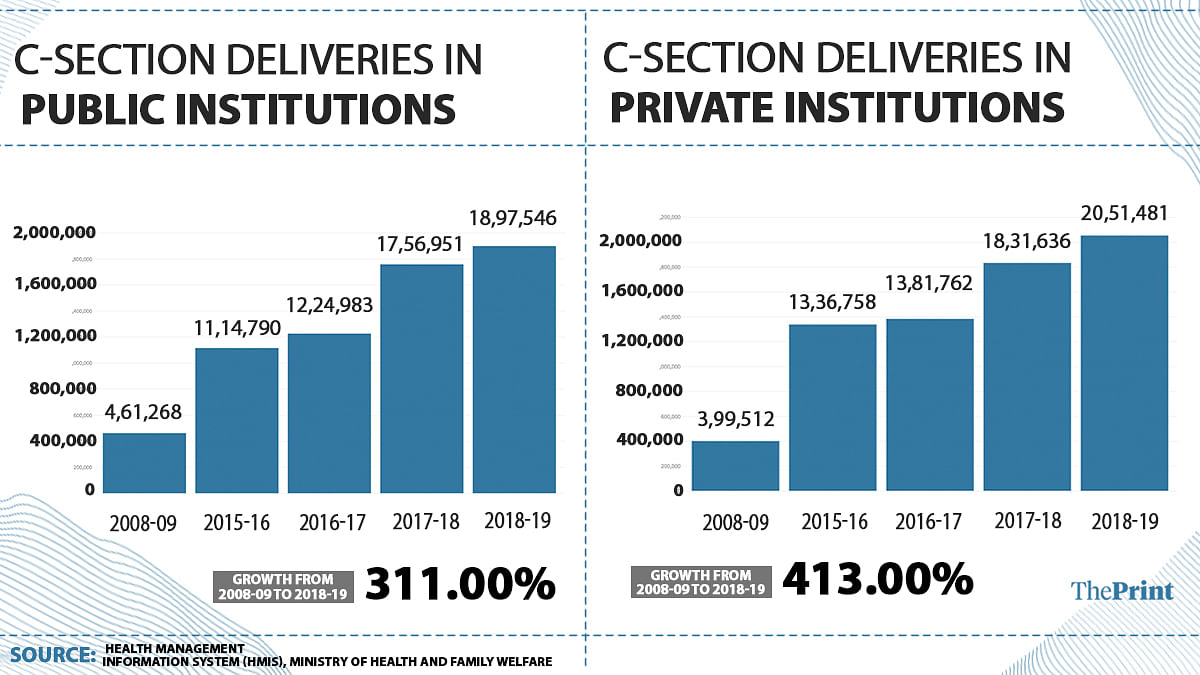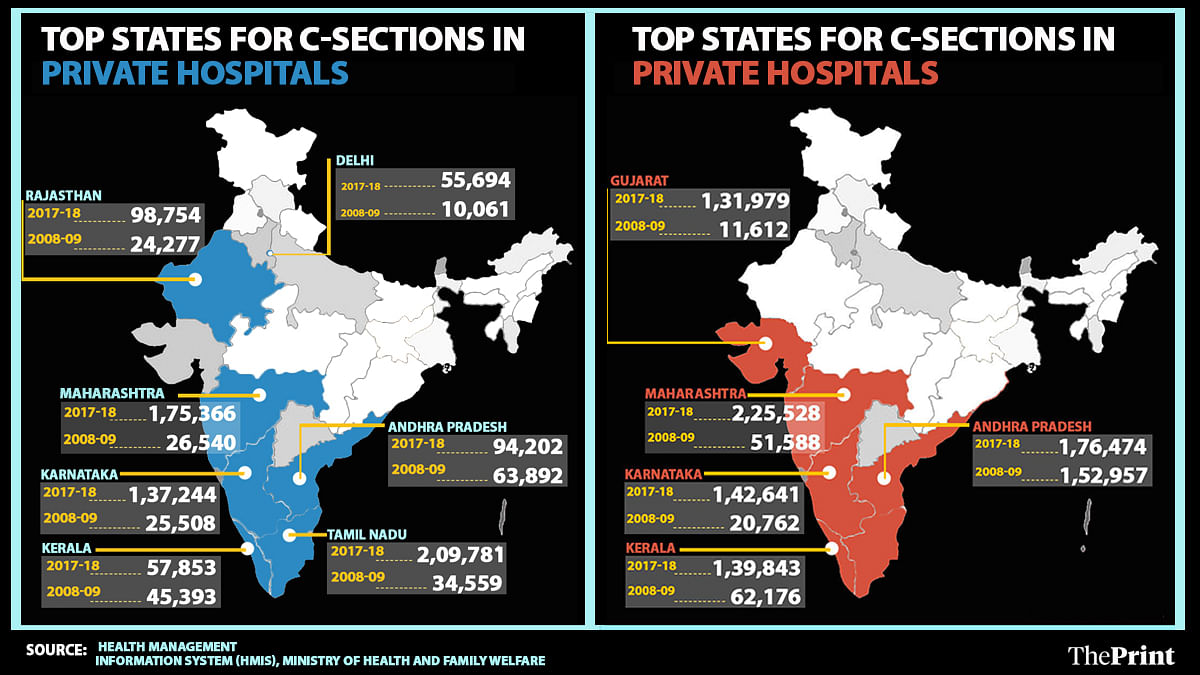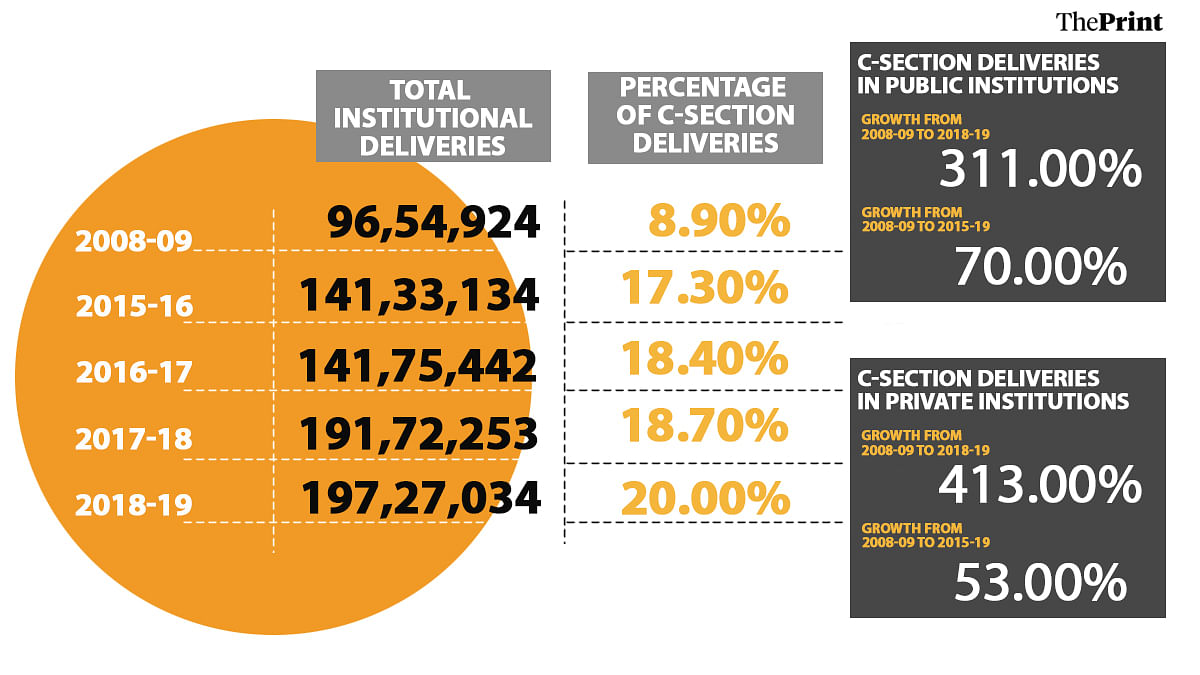New Delhi: Indians are opting for cesarean operations for delivery of children more than ever, latest government data shows.
Since 2008-09, cesarean-section deliveries — also known as C-section — have doubled in India at both government and private hospitals.
C-section is a surgical procedure used to deliver a baby through incisions in the abdomen and uterus. According to the guidelines laid down by the World Health Organization (WHO), the procedure should only be used in complicated pregnancies.
C-sections have, however, become increasingly common in both developed and developing countries, including India, where experts call the trend “an epidemic”, blaming it on an “unregulated market”, financial incentives and an increasing trend of women opting for it.
India has registered a jump of over 300 per cent in C-section deliveries at public hospitals, and 400 per cent in private hospitals in the last decade.
According to data collected by the Union Ministry of Health and Family Welfare under the Health Management Information System (HMIS), over 14 per cent of the total births in 2018-19 took place through a C-section — around 19 lakh births out of the total 1.3 crore — in public hospitals.
A decade ago, this number was less than half of the current.
In 2008-09, the public hospitals registered total 73.13 lakh births, of which 4.61 lakh were C-sections — just a little over 6 per cent.
The scenario is the same at private hospitals that are usually blamed to be “C-section friendly” considering the fact that the surgery requires longer hospitalisation leading to higher billing.
In private hospitals, C-sections have quadrupled from 4 lakh in 2008-09 to 20.5 lakh in 2018-19. A decade ago, these surgeries accounted for 17 per cent of the total births at private hospitals, which have now doubled to 33.8 per cent.

“C-section is a supplier-induced demand driven by monetary incentives. In this case, supplier is a hospital who can sell the product to a patient with limited information. Due to the unregulated market and no clear protocols, India is facing an epidemic of C-sections,” said health economist Indranil Mukhopadhyay, who is an assistant professor at O.P. Jindal University.
Also read: TB cases down but India still has 27% of all global patients, tops WHO list
Pros and cons of C-sections
C-section operation has been labelled by some quarters as “medically unjustified”. “For the newborn, it means delayed breastfeeding, lower birth weight, respiratory morbidities, increased rate of hospitalisation, lower Apgar scores and its implication in the long run,” says a study conducted by IIM, Ahmedabad.
However, it is also considered a life-saving procedure that could be performed during pregnancy complications when a vaginal delivery seems challenging.
“If not abused, C-section is a medical boon when there are complications in natural, vaginal delivery due to a variety of reasons such as abnormal positioning of child,” said Dr Dr Subhasri B, a gynaecologist who works with a civil society group, CommonHealth, on maternal issues.
According to WHO, medical practitioners “should not undertake caesarean sections purely to meet a given target or rate, but rather focus on the needs of patients”.
It adds, “Caesarean sections can cause significant complications, disability or death, particularly in settings which lack the facilities to conduct safe surgeries or treat potential complications. Due to their increased cost, high rates of unnecessary caesarean sections can pull resources away from other services in overloaded and weak health systems.”
Top states opting for C-section deliveries
The highest cesarean rates have been observed in South India, apart from Maharashtra.
Andhra Pradesh, Karnataka, Kerala and Tamil Nadu registered most C-section births last year, in both private and public hospitals.

The number of C-section births has sharply increased in contrast to 2008-09 when this surgery was usually not preferred by the families.
In Maharashtra, the C-section deliveries shot from 26,000 in 2008-09 to 1.75 lakh in public hospitals, and from 51,000 to 2.25 lakh in private hospitals.
In Karnataka, these births have increased from 25,000 in 2008-09 to 1.37 lakh in 2018-19 in public hospitals, and from 20,000 to 1.4 lakh in private hospitals.
Also read: World’s largest study on newborns with brain injuries begins in India
Why C-sections are increasing?
According to medical experts, the pain threshold of patients is increasingly falling leading to voluntary demand of C-sections. “In my experience, out of 10, six patients quit the normal delivery route because they fail to stand the pain. Even the relatives request to opt for C-sections despite counselling and motivation,” said Dr Sadhna Singhal, senior consultant at Delhi-based Sri Balaji Action Medical Institute.
Medically, doctors need to adopt the procedure in cases such as breech position — where the baby’s feet will be positioned to be delivered first. “Other cases will be complicated pregnancies where either mother has history of a disease or the baby is suspected to be born with abnormalities. Also, we need to immediately opt for c-sections when the baby passes meconium stool while still in the uterus,” Singhal added.
Citing other reasons for increasing C-sections, Mukhopadhyay from OP Jindal University blamed the government for offering zero payment on normal deliveries but a “decent money” for surgeries.
“There is higher compensation for C-sections and much convenience in conducting the surgery, where as for normal deliveries there is hardly any additional financial incentive. For instance, on an average, 55 per cent of C-sections take place in private hospitals under the insurance schemes whereas 17 per cent of C-sections are undertaken in public hospitals,” Mukhopadhyay said.
Also, the C-section increases the out-of-pocket expenditure. According to a study by the Indian Institute of Management, Ahmedabad, natural delivery in a private facility costs, on an average, Rs 10,814, while a C-section costs Rs 23,978.
“The reason why C-sections are increasing in public sectors in some states is also due to the increased monitoring of quality and cautious approach against the poor outcomes, public sector doctors have told me. While they have no monetary encouragement related to surgery-based deliveries, the doctors choose c-sections even if the case is slightly complicated. They don’t want to be hauled up in inquiries later on,” said Dr Subhasri.

Also read: Cap on age limit for IVF could be allowed, but only with checks and balances
WHO threshold crossed, says study
According to a research published in medical journal Jama Network Open in March, the cesarean birth rate in India is above the benchmark set by the WHO.
“The rate of cesarean births is increasing in India and has already crossed the World Health Organization threshold of 15 per cent,” concluded the study.
In 2018-19, India conducted 20 per cent of the total institutional deliveries through C-section, against 18.7 per cent in the previous year.
The rate is above the levels observed in richer countries such as The Netherlands or Finland.
In 2008-09, this figure in India was 8.9 per cent.
The study, conducted by researchers at the French Research Institute Development (IRD), further estimated that India recorded an annual excess of 18 lakh cesarean births from 2010 through 2016, “concentrated in more advanced regions and affluent classes”.
However, it also highlights that India suffers a twin problem where it faces deficit of access to cesarean deliveries in poorer communities and the emerging overuse of cesarean delivery in more affluent regions and social groups.
“During the same period, India recorded an annual deficit of 0.5 million cesarean births concentrated in underprivileged regions and populations among whom home deliveries remained frequent and cesarean rates remained low even among births in health facilities,” the study said.
Also read: WCD ministry refutes survey that claims maternity scheme missed 51% of beneficiaries




this is lazy reporting…. without showing a corresponding decrease in MMR & IMR entire data scare tactic seems “bogus”